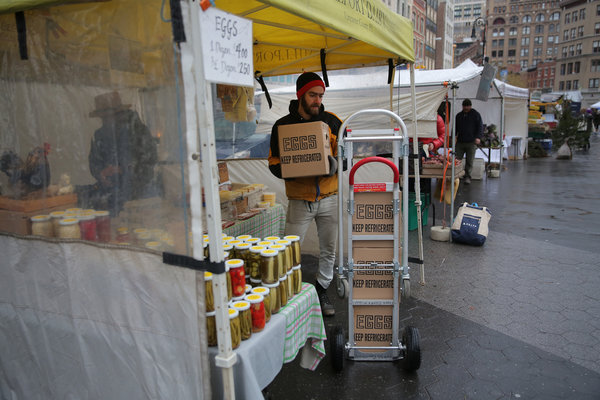Start-Ups Rise to Close a Gap for Farmers
January 14, 2015
Source: The New York Times
Author: Stephanie Strom
WELLESLEY, Mass. — In spite of the surging demand for locally and regionally grown foods over the last few years, there is a chasm separating small and midsize farmers from their local markets.
But a growing number of small businesses are springing up to provide local farmers and their customers with marketing, transportation, logistics and other services, like the Fresh Connection, a trucking business providing services to help farms around New York City make deliveries.

Mark Jaffe of the Fresh Connection picks up fresh eggs from a farmer’s stand in Union Square, Manhattan. He will make deliveries to restaurants and groceries.
The brainchild of Mark Jaffe, who previously organized tenants for bargaining purposes, the Fresh Connection expects to close this year with revenue of $270,000, up from just $5,300 when it started in 2012.
“It’s not sexy, but I like doing it,” Mr. Jaffe said. “When it got to be too much to fit in my car” — a Toyota Matrix — “I rented a refrigerated truck and it just took off from there.”
The business now leases three such trucks and has four full-time and two part-time employees, and Mr. Jaffe hopes to secure financing that would help him add warehouse facilities so he could better manage delivery of perishables like eggs and chocolate.

In his truck, Mr. Jaffe checks his delivery list. Credit Michael Appleton for The New York Times
“There’s been a huge explosion of companies that in various ways are trying to address the gap between farm and fork,” said Alan Kaufman, the proprietor of Shibumi Farm in Princeton, N.J., which grows exotic mushrooms. “Some of them are just a lot of buzz — there are some real challenges — but a few are figuring out how to do it.”
The Fair Food Network, a nonprofit organized to improve access to better food, recently held a second “business boot camp” in Wellesley, Mass., for tiny companies working to increase ties between communities and local farmers, which culminated in a contest to win some $10,000.
Over the last four or five decades, the American food system became dominated by larger and larger farms selling into highly integrated and centralized distribution programs aimed to serve big food companies, restaurants and national grocery chains.
Then Whole Foods came along and demonstrated that there was money to be made in local agriculture. Not only did the upstart grocery company devote more of its floor space to produce and fresh meats, it distinguished itself from competitors by sourcing part of each store’s merchandise from local vendors and using that distinction as a marketing advantage.
That helped propel interest in farmers’ markets and community-supported agricultural shares, or C.S.A.s, which in turn inspired companies like Fresh Direct to create virtual farmers’ markets. “It’s continuing to grow, both in the number of local farms supplying us and the number of local and regional products we offer,” said David McInerny, a founder of Fresh Direct.
As the business has grown, Fresh Direct has ramped up the support it gives farmers, Mr. McInerny said. Customers can click the word “local” on the home page of the company’s website and get to a page that allows them to order cheese, seafood, meat and other items sourced within 300 miles of their home.
“Great farmers should be just that, great farmers, not necessarily great distributors,” he said.
For farmers selling products to a number of customers, there are so-called food hubs like Red Tomato, which connects its network of farms to existing wholesale distribution systems to make deliveries of locally grown fruits and vegetables to groceries, produce distributors, restaurants and schools in the Northeast.
The organization started out handling warehousing and distribution itself, but could never achieve the economies of scale it needed. “That’s a lot of refrigeration and logistics, which in turn required employee training and a lot of technology and other investment, and we asked ourselves whether that was really what we wanted to go to bed worrying about,” said Michael Rozyne, Red Tomato’s founder and co-director.

Cassandria Campbell and Jackson Renshaw, the founders of a catering service, speaking at a “business boot camp” in Massachusetts. Credit Katherine Taylor for The New York Times
About 40 percent of the final sales price goes to Red Tomato’s farmers and 10 percent to the hub. That may sound generous, but Mr. Rozyne said there was constant pressure to improve efficiency and bring down prices to levels competitive with the broader commodity supply chain.
Recent research found that many food hubs had become self-sustaining and even profitable, but in the last year, several also have gone out of business. Grasshoppers Distribution, a food hub in Louisville, Ky., failed late last year, and MOO Milk and Coastal Farms and Foods in Maine also have closed. “I think the honeymoon period for food hubs is coming to an end,” Mr. Rozyne said.
Yet at the same time, he noted the number of start-ups involving stalwarts of the tech industry that are springing up to improve the connection between farmers and local markets. “It’s almost scary how many of these things there are,” he said. “There’s some pretty serious venture capital money flowing into this business.”
He could have been speaking of FarmersWeb, an online marketplace that connects farmers to buyers. Founded in 2012 by David Ross, who formerly worked at a venture capital firm, and two other partners, FarmersWeb raised almost $1 million from angel investors to get started.
Mr. Kaufman of Shibumi Farm uses FarmersWeb to connect to his customers, who can see what he has in stock, negotiate prices, arrange shipping and even pay using the system.
“In a way, it’s like outsourcing the research I would otherwise do myself to find local suppliers,” said Alex Saper, managing partner and chief operating officer at Eataly, a food emporium in Manhattan.
When Michael Navarrete moved to New York from Boston to be the executive chef at Café Luxembourg, one of his biggest concerns was how he would build the relationships with local farmers that he had enjoyed with such growers in Massachusetts.
FarmersWeb did the job for him, he said. “A lot of these guys don’t have time to be making sales calls — they’re out raising pigs or kale,” Mr. Navarrete said. “And I don’t always have time to be taking calls from farms or their delivery services.”
Not all ways of improving consumer access to local and regional farm production involve distribution, however. Blue Ox Malthouse, for instance, is making malt from barley grown in Maine as a cover crop. Normally, farmers plow barley under or sell it cheaply for animal feed.
.jpg)
Mr. Jaffe picks up apples from a farmer’s market in Manhattan for delivery. Credit Michael Appleton for The New York Times
Blue Ox has given them a new and more lucrative market, though, buying up barley and turning it into malt in hopes of selling it to Maine’s thriving craft beer businesses.
Most of the malt used in beer is made by two large companies, and Maine brewers are importing almost 76 million pounds of malt from them each year, according to Joel Alex, who founded Blue Ox last year.
That means about $35 million that leaves the state, he said.
“It’s good for the farmers, who get a better price for a product they often just plowed under, and it’s good for the craft beer business, where brewers are always looking for points of distinction,” Mr. Alex said.
He and Mr. Jaffe were among five participants in the boot camp at Babson College. The training was sponsored by the Fair Food Fund, a venture capital fund set up by the Fair Food Network to invest in what it calls “the missing middle,” the infrastructure to connect small and midsize farms to the growing demand for their products.
The participants had lessons in financial accounting, different types of financing, business models and other matters from Jay Friedlander, a senior fellow at Babson and founder of the sustainable business program at College of the Atlantic in Bar Harbor, Me. They then pitched their businesses to a group of judges in hopes of winning $10,000 worth of consulting from experts who work with the Fair Food Fund.
The business that won, Fresh Food Generation, uses ingredients bought from farms in the Boston area for a catering service, the proceeds of which will help support a food truck that was bought using $54,000 raised on Kickstarter.
The plan is to bring into low-income neighborhoods nutritious meals that reflect cuisines like Caribbean, Cuban and Argentine, and are made from ingredients supplied by local farms. Cassandria Campbell, who grew up in such a neighborhood, Roxbury in Boston, got the idea after seeing a boy coming out of a fast-food restaurant who could barely walk because he was so overweight.
“I thought, How could his parents let him eat there?” Ms. Campbell said. “But when I looked up and down the street, there weren’t any better alternatives.”
The catering business has taken off — Fresh Food Generation has provided meals at 20 events with a total of over 2,000 people in the last 10 months — but she and her co-founder, Jackson Renshaw, have struggled to get the other aspects of their business moving.
“We are juggling getting the food truck going, the catering business and community outreach all at the same time,” Mr. Renshaw said. “It’s really challenging making our business model work because you’re pulled in so many directions at once.”
They plan to use their prize to get advice about how to set priorities and better manage their finances.
Correction: January 1, 2015
An article on Wednesday about so-called food hubs that seek to connect local farmers with customers misstated the year that an online marketplace called FarmersWeb was founded. It started in 2012, not in 2013.
First posted at New York Times on December 30, 2014. A version of this article appears in print on December 31, 2014, on page B1 of the New York edition with the headline: Start-Ups Rise to Close a Gap for Farmers.







